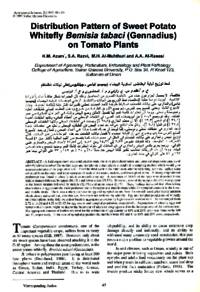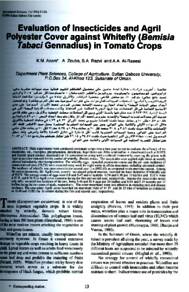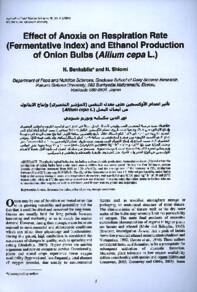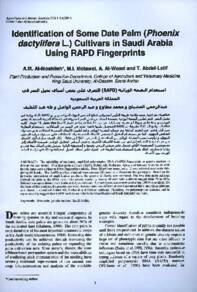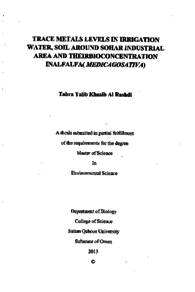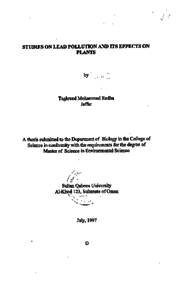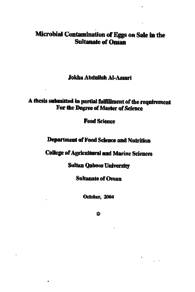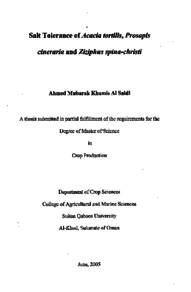Document
Distribution pattern of sweet potato whitefly bemisia tabaci (gennadius) on tomato plants.
Contributors
Publisher
Sultan Qaboos university
Gregorian
1997
Language
English
English abstract
A field experiment was conducted to study the intra plant distribution and temporal dispersion patterns of whitefly (Bemisia tabaci Gennadius) eggs and nymphs on tomato plants to establish a sampling method which would give accurate estimates of the population size. From the third week to the ninth week after transplanting, terminal leaflets were collected from the outer and inner canopies of each of the upper, middle, and lower plant strata. A strong ovipositional preference was found in whitefly adults at an early crop age. A maximum of 50.6% of the eggs were deposited in the middle stratum followed by upper (36.1%) and lower strata (13.3%). However, most of the nymphs (65.5%) were present in the lower stratum followed by middle (32.4%) and upper strata (2.1%). These findings indicated that when taking observations in egg counts the most preferred site is the upper and middle strata while for nymphal counts it is the lower and middle strata. There was a sharp decrease in egg and nymphal counts from the seventh week after transplantation which clearly indicated that, after this age, the crop is not preferred by whitefly. Egg and nymphal populations of whitefly on tomato plants in the field were distributed in aggregates as evident by high variance to mean ratio. Values ranged from 2.72 to 14.36 and 4.52 to 21.82 for egg counts and nymphal population, respectively. Aggregation of whitefly eggs and nymphs in all cases might be due to the behavior of adults to congregate and to the heterogeneity of the environment. The appropriate number of leaflets required for the estimation of egg density at 10% and 20% error was found to be 149 and 37, respectively In the case of nymphal population the numbers were 163 and 41 at 10% and 20% error, respectively.
Member of
ISSN
2410-1079
Resource URL
Citation
Azam, K. M., Razvi, S. A., AlMuhthuri, M. H., & AI-Raeesi, A. A. (1997). Distribution pattern of sweet potato whitefly bemisia tabaci (gennadius) on tomato plants. Journal of Agricultural and Marian Sciences, 2 (1), 43-50.
Arabic abstract
لا يحصل المزارعون عادة على الإنتاجية القصوى من المحاصيل وذلك لأن الحشرات تشكل عائقا أساسيا لزيادة الإنتاجية. أجريت دراسة حقلية لاستقصاء نمط التوزيع بين النباتات والانتشار الزمني لبويضات الذبابة البيضاء (بيميسيا تباسي) والعذارى، على نباتات الطماطم، استنباط طريقة لأخذ العينات تعطي تقديرات أكثر دقة للكثافة العددية. ومنذ الأسبوع الثالث وحتى التاسع بعد الغرس، تم جمع الأوراق الطرفية من خارج وداخل الغطاء النباتي للطبقات العليا والمتوسطة والسفلى. ووجد أن الحشرات كاملة النمر لها تفضيل لأماكن وضع البيض وذلك في المراحل المبكرة من نمو النبات. ولقد تم وضع 50.6% من البويضات، كحد أقصى، في الطبقات الوسطى من الغطاء النباتي، وتلتها الطبقات العليا (36.1) ثم السفلى (13.3). إلا أن معظم العذارى (65.5%) وجدت في الطبقات السفلى وتلتها الطبقات الوسطى (32.4%) ثم العليا (2.1%). وتدل هذه النتائج على أنه عند تعداد البيض فإن الطبقات الوسطى و العليا هي المفضلة، بينما توجد العذارى في الطبقات السفلى والوسطى. كما لوحظ أن هناك نقصا حادا في أعداد البيض والعذارى بعد الأسبوع السابع للغرس مما يدل بوضوح على أن الذبابة البيضاء لا تفصل نباتات الطماطم بعد هذه المرحلة من نمو النبات. كان توزيع البيض والعذارى على نباتات الطماطم في الحقل في مجموعات، كما يتضح من القيم العالية (أكثر من 1) لنسبة الانحراف : المتوسط. ولقد تفاوتت القيم من 2.27 إلى 14.36 ومن 4.52 إلى 21.82 لأعداد البيض والعذارى على التوالي، وربما يعزى تكدس البيض والعذارى في كل الحالات إلى سلوك الحشرات كاملة النمو وميلها للتجمع وعدم تجانس البيئة. ووجد أن عدد الوريقات المناسب لتقدير كثافة البيض عند خطأ 10% و 20% هو 149 و 37 على التوالي بينما هو 163 و 41 على التوالي في حالة العذارى.
Category
Journal articles

